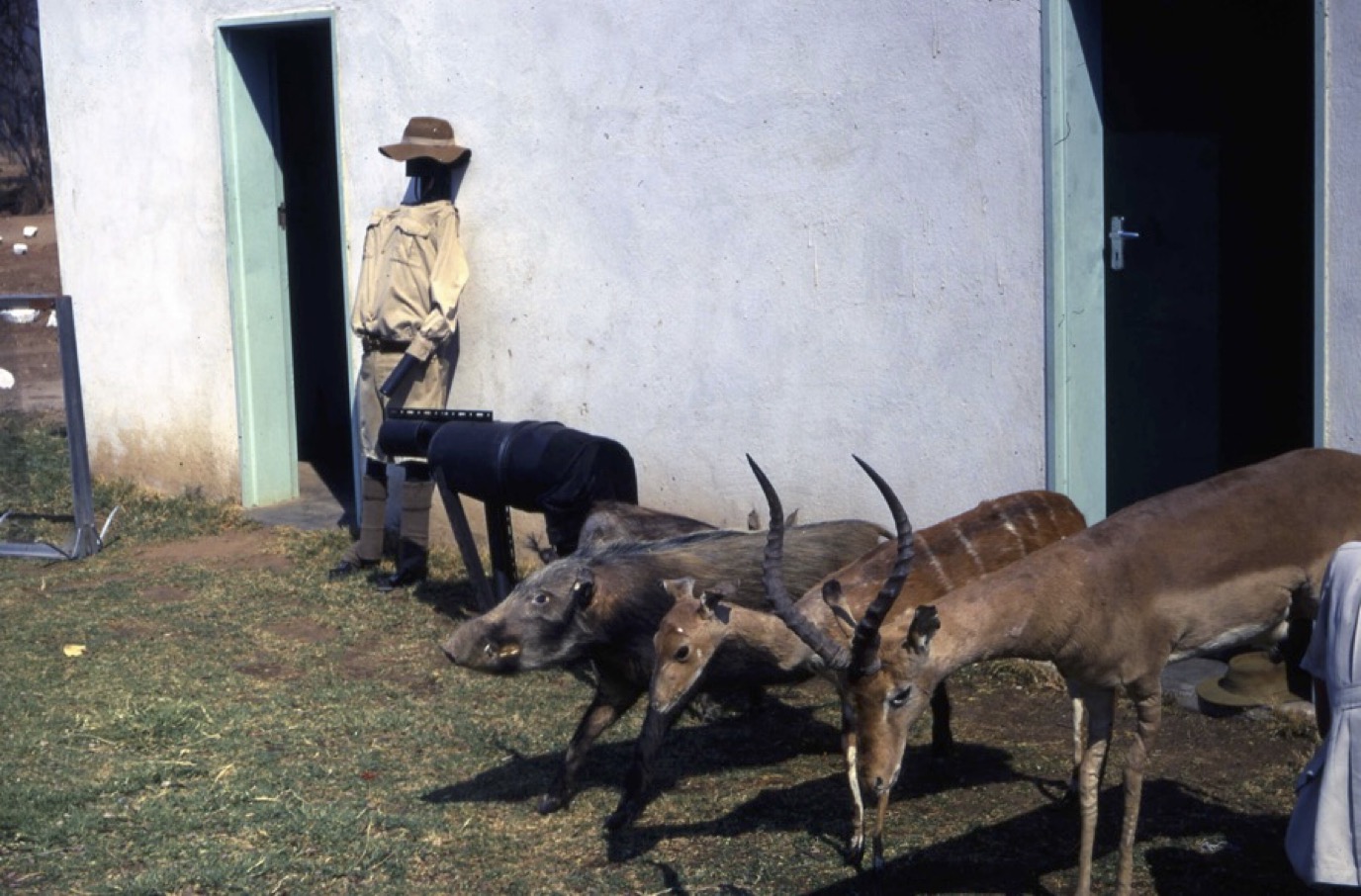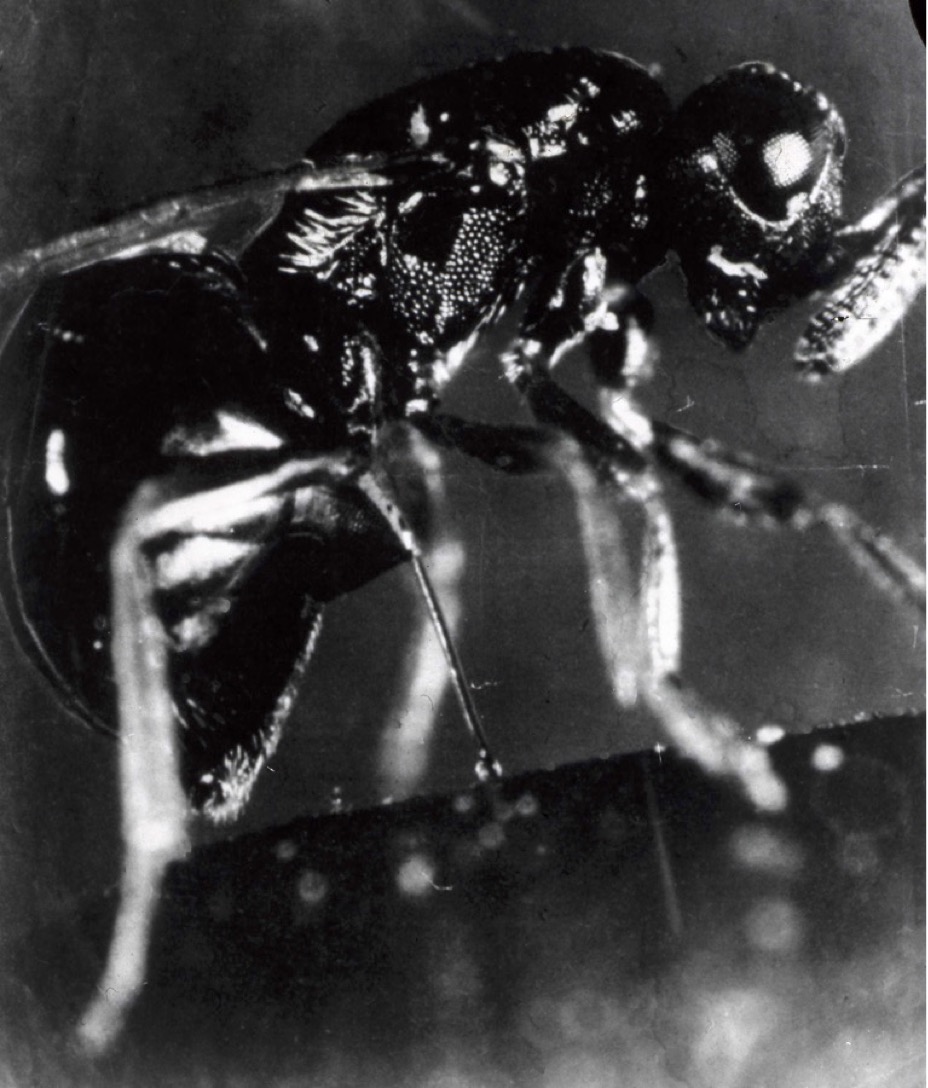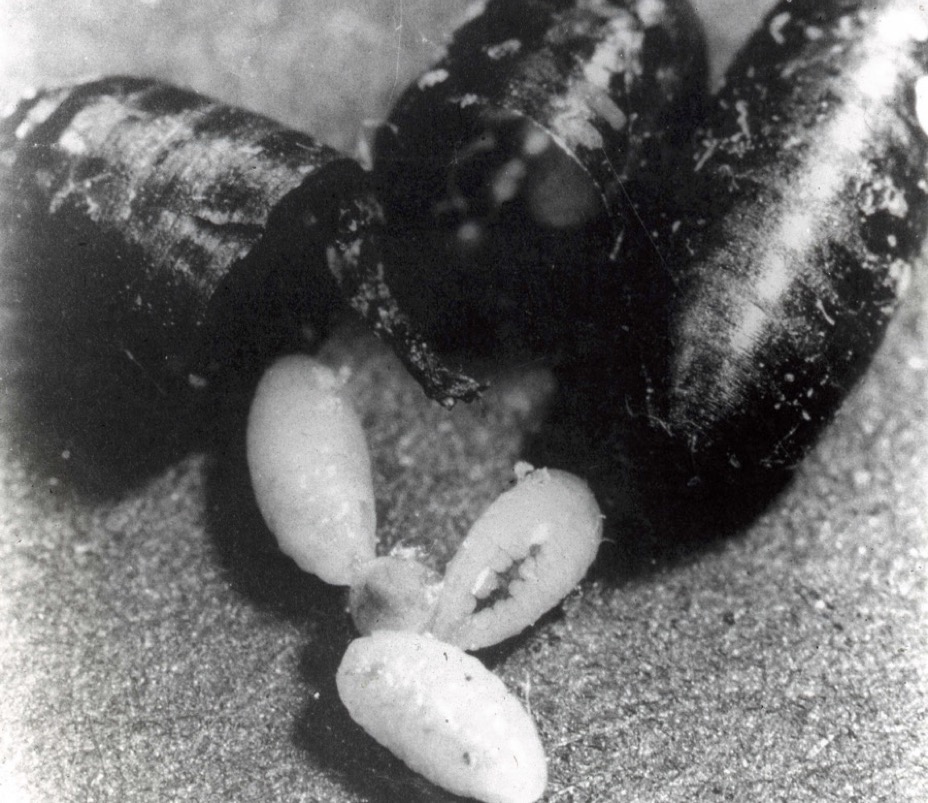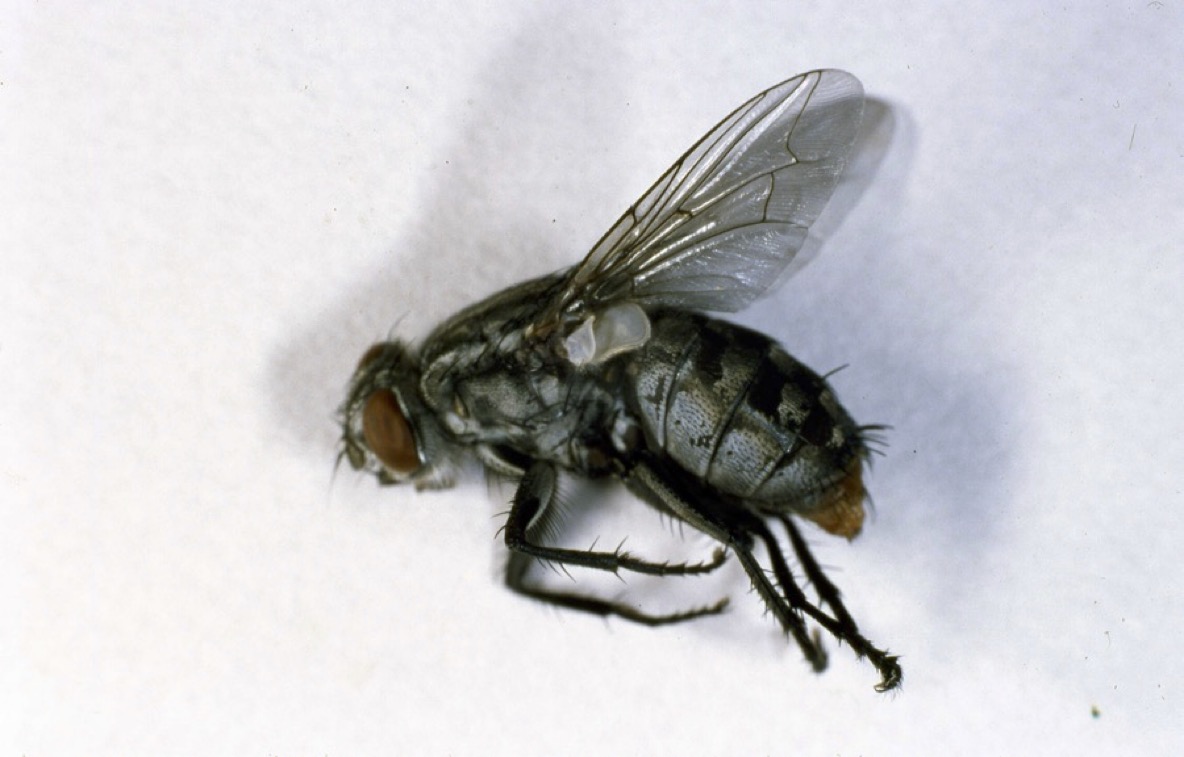In 1970 I attended the International Congress of Parasitology, held that year in Washington D.C., and presented a paper on tsetse fly reproduction and the effects of the unknown toxicant. I also took the opportunity of visiting Professor Carroll Williams at Harvard and met several life-long friends there including Jim Truman and Lynn Riddiford – but more of this later because it concerns the change in my research ‘direction’ which I will soon recount.
Back in Edinburgh I picked up work on tsetse flies again. By this time I was interested in the stimuli leading to ovulation. Virgin flies fail to ovulate the first egg from the right ovary, and in some unmated females fully-formed eggs may pile up in the ovaries. Mated flies, on the other hand, ovulate promptly in the sequence described earlier. Tsetse flies are unusual among the ‘higher’ flies in that the male constructs a small capsule or spermatophore within the female’s uterus and then fills that with sperm. This of course takes time, and tsetse flies may remain in copula for an hour or longer while this process takes place, in stark contrast to the very quick mating habits shown by, say, house flies or blow flies. My research at this point was concerned with the question: what components of the mating act stimulate ovulation? It was clearly related to time in copula since females mating for about 45 minutes or less rarely ovulated on time. Passage of sperm into the spermatophore was not the factor in question because the construction of empty spermatophores within the uterus by old and exhausted males usually led to normal ovulation. It was concluded that a component of the mating act itself, mechanical or humoral, was the factor involved.
At this point I arranged a six-week research trip to Lisbon in the summer of 1970 to further this work, and to avail myself of the facilities of Professor Azevedo’s colony of G. morsitans. We spent six weeks in Lisbon as a family, driving down to Southampton, taking the overnight ferry to Bilbao and then continuing on via Burgos, Valladolid and Salamanca to Lisbon where we took a small apartment in Cascais, near Estoril. Jean and the children spent their days on the beach whilst I took the morning commuter train into Lisbon to the Tropical Institute, before returning at lunch time to join the family on the beach. Before leaving Edinburgh I had envisaged using many experimental flies from the large colony maintained in the Institute but, upon arrival, learned that an accident had occurred. Apparently, cockroaches had been seen in the fly room by a cleaner who, without permission of course, treated the area with an insecticide. Very few flies were left by the time I arrived in Lisbon, but some were still available – and I could spend more time on the beach! The experiment that I did perform was a rather gruesome one that entailed surgically removing the penis from male flies. Surprisingly, perhaps, such mutilated flies adopted their normal mating position, even though penetration was not possible, and prompt ovulation followed. This result seemed to confirm the operation of some sort of mechanical stimulus. At the end of the six weeks in Portugal, we returned to the U.K. via Evora, Caceres, Avila and Segovia, to visit the Altamira caves in northern Spain before sailing back to Southampton.

Tsetse fly ‘baits’ in Rhodesia, 1971
In September 1971 I was invited by Professor Einar Bursell to a meeting on tsetse flies held at the University in Salisbury, Rhodesia (now Harare, Zimbabwe) and jumped at the chance to see tsetse flies in the southern part of their range in Africa. In September I first flew out to Nairobi to visit the newly established International Centre for Insect Physiology and Ecology (ICIPE). Since most airlines had discontinued flights to Salisbury because of UDI, I then flew to Blantyre in Malawi, which for economic reasons still maintained contact with Rhodesia, and then on to Salisbury. After the meeting I flew back on a South African airways flight which, because of restrictions in over-flying most African states, landed in the Cape Verde Islands en route for Lisbon and London.

Tsetse fly cleaning station, Rhodesia 1971
My research on tsetse flies came to a rather abrupt end in 1971 for reasons that I will now recount. Earlier that year I had applied for a grant from the Overseas Development Administration (ODA) to maintain the tsetse colony for a few more years. Soon after I heard that my application had been successful, complications arose. One evening during a visit to Edinburgh by Jim Truman and his new wife, Lynn Riddiford, I received a telephone call from Professor Colin Pittendrigh inviting me to spend a year at Stanford University, Palo Alto, California. Actually, the whole business was a great deal more complicated than that. Pitt had invited me to spend a year in his laboratory when he was still at Princeton in 1969, before he moved out to Stanford. For one reason or another, this letter never got posted to me and Pitt thought that I was just not interested (and probably very rude for not answering!). However by 1971 with his transfer to Stanford completed, Pitt discovered this letter, stamped but un-posted, on his desk – and promptly forwarded it to me in Edinburgh. Unhappily, this coincided with a postal strike in the U.K. and the letter was again delayed. Once again Pitt could not understand why I ignored his offer – and was probably and understandably miffed. To cap it all, when the letter finally did arrive, causing great excitement, it blew away in Princes Street leaving me with no concrete evidence of its existence! Luckily one of the good citizens of Edinburgh picked it up and forwarded it to me at the Zoology department, and the invitation was at last received. I answered it immediately in the affirmative, and then came the telephone call repeating the invitation, stressing that now was the time to come since money was now available. Naturally, I accepted on the spot and with a few weeks was on my way to the United States.
I wrote to the ODA asking that my newly awarded grant be put on ice for a year while I was on sabbatical at Stanford, something that I and my Head of Department (Peter Walker) thought quite reasonable. Unfortunately however, Professor Kershaw, then chairman of the ODA Trypanosomiasis panel, thought that I was ‘playing the game’, i.e. applying for a grant when knowing full well that I would be out of the country. He said that he “was coming up to Edinburgh to see Professor Walker, did not want to see Saunders, and would sort it all out”. He did come up to Edinburgh and Peter calmed him down informing him of the truth of the situation. By the time he left he had agreed that I should contact him toward the end of my stay at Stanford, and then the ODA might reconsider the grant. This I did in due course, but merely got a reply to say that financial support was no longer available. This meant that within a few days of my return to Edinburgh, money ran out, staff had to be dispersed, and all the flies died. Thus my active participation in tsetse fly research came to an abrupt end.
I must now turn the clock back almost 10 years to recount how I became involved in insect diapause, photoperiodism, and other aspects of biological time-keeping, a field of enquiry that would last until the end of my career. Forty years ago this aspect of biology was regarded by many as bordering on the mystical – but now, particularly after the ‘molecular revolution’ of the 1980s and 1990s, it has come to occupy centre stage in modern biology. In making this change, I got to know most of the ‘giants’ of chronobiology: Jűrgen Aschoff (circadian rhythms in birds and humans), Erwin Bűnning (circadian rhythms in plants, and photoperiodism), Alexander Danilevskii (insect photoperiodism), Tony Lees (photoperiodism in mites and aphids), Colin Pittendrigh (circadian rhythms in fruit flies, photoperiodism) and Carroll Williams (diapause endocrinology). These and many others will feature in the account that follows.
My involvement with this field began during my Ph.D. work at the London School of Hygiene and Tropical Medicine when I made my own personal discovery of diapause in the parasitic wasp Nasonia vitripennis, as related above. I then saw the very influential book by A.D. Lees, The Physiology of Diapause in Arthropods, published in 1955, which illustrated (his Fig. 3) the relationship between day length (photoperiod) and the incidence of diapause, so characteristic of a multitude of insects and other organisms living in temperate areas. This book provided me with the impetus to carry on with this work. After my move to Edinburgh in 1958, therefore, I returned to the study of this phenomenon. From the early 1960s until the 1980s I obtained a series of research grants from the Department of Scientific and Industrial Research (DSIR), then to become the Science Research Council (SRC) and then the Biotechnology and Biological Sciences Research Council (BBSRC), to fund my work. This enabled me to employ a series of technicians and to purchase pieces of capital equipment. At the time, the excellent ‘dual funding’ mechanism for scientific research meant that incidental expenditure was met by funds allotted separately to the University and administered by the Departmental head. This method of funding was so much more efficient than the Thatcherite methods adopted in the 1980s which necessitated all expenditure, including University ‘overheads’ to be specified and included in the original application. Throughout this period I was thus amply and generously supported by my Head of Department, Professor Murdoch Mitchison.
I soon found that larval diapause in Nasonia was induced by autumnal short days, but not on the larvae themselves. It was a maternal effect, parent females exposed to the long days of summer laying eggs developing without arrest, those exposed to day lengths less than about 14 hours producing progeny that ceased development (entering diapause) just before the point at which their long-day siblings formed pupae. This diapause was found to be ‘deep’ or ‘intense’, persisting for up to two years at room temperature unless the diapausing larvae were exposed to a few weeks of chilling. The maternal response showed an abrupt transition (critical day length) between the diapause-inducing short days and the development-inducing long days at about 14½ hours of light per day. Nasonia vitripennis, like many insects of the temperate regions, was thus a ‘long-day’ species. Transmission of photoperiodic ‘information’ from one generation to the next was found to be truly maternal, reciprocal crosses between strains of wasps from different geographical regions (Cambridge, England, and Woods Hole, Massachusetts), with different diapause and photoperiodic characteristics, showing that these characteristics in the immediate progeny were exactly like those of the mother, whereas the father’s characteristics only appeared in his grandchildren.
Careful analysis of the entire progenies of wasps kept under different day lengths was performed by keeping females singly in small glass tubes, supplying them each day with two fresh puparia of their host, the fly Sarcophaga argyrostoma, and then keeping the parasitised hosts for another two weeks to see whether the wasp larvae pupated (non- diapause) or became dormant. This experimental procedure showed that wasps under short days produced their first progeny as nondiapause larvae and then, one by one, switched to the production of diapausing larvae. Since each day’s batch of larvae, and hence the eggs from which they had developed, were the product of an adult female after a certain number of photo-cycles, this strongly suggested that the female wasp was capable of accumulating (‘adding up’) the physiological effects of successive photo-cycles, short or long, to some sort of internal maternal threshold at which diapause (or continuous development) was determined. Moreover, the rate of that accumulation was for all intents and purposes independent of temperature, at least between 15 and 30 °C, the ‘ecological’ range. Survival of the female wasps and their daily rate of egg production, however, were temperature dependent, occurring more rapidly at 30 than at 15 °C. This meant that, at high temperature, most progeny were produced early in adult life and became non-diapause larvae, whereas at low temperature, egg production was delayed and they developed into diapausing larvae. This interaction between the temperature dependent rate of egg production and the temperature compensated accumulation of inductive short day cycles went a long way to explaining the major effects of temperature.


The parasitic wasp, Nasonia vitripennis. Adult wasp (upper panel) and diapause larvae (lower panel).
on diapause incidence. Since temperature compensation was one of the canonical features of circadian rhythms (see below) and these rhythms were being actively proposed by several workers as the ‘clockwork’ behind photoperiodism, my research naturally turned to a consideration of these innate ‘daily’ oscillations.
At this time I began to read the ground-breaking papers by Colin Pittendrigh. His main interests were in circadian rhythms of all organisms from protozoa to mammals, but especially those of the fruit fly Drosophila pseudoobscura which displayed extremely accurate rhythms of emergence from the puparium (so-called eclosion rhythms). Pitt’s work had shown that (probably all) animals and plants ‘above’ the bacteria displayed endogenous near-daily rhythms of physiology and behaviour with the following properties. All had an innate period (observable in the absence of an ‘environmental’ light cycle, i.e. under continuous darkness, or sometimes light) that was close to, but rarely exactly, 24 hours. Moreover, in continuous darkness the periods of these (‘free-running’) rhythms were temperature compensated (almost the same across the ecological range of temperature), but could be entrained to an exact 24 h by the environmental cycles of light and darkness, and to a lesser extent by temperature cycles and a few other temporal cues. In the late 1950s and early 1960s Pitt also became an enthusiastic and vociferous supporter of Erwin Bünning’s idea (later called ‘Bünning’s hypothesis’) that such rhythms might provide the timing mechanism for seasonal photoperiodism. Without going into the details of the experiments he performed, Pitt’s work demonstrated remarkable parallels between the behaviour of overt circadian rhythms and the covert, presumably circadian, events underlying photoperiodism. These results led him to propose several circadian-based models, the most generally applicable being that of ‘external coincidence’. This model suggested that it was night length rather than day length that was ‘measured’, and that the circadian oscillation(s) involved placed a particular light-sensitive phase toward the end of the night in such a position that it would be illuminated by dawn under the long days (short nights) of summer (= non-diapause) but remain in the dark of an autumnal long night (= diapause).
Results of my experiments with Nasonia were consistent with the proposition that circadian rhythms provided the photoperiodic clockwork. This was particularly true of an experiment I performed using very long 72 h photo-cycles containing a 12 h ‘main’ photophase, and a 60 h accompanying dark period systematically interrupted by a short supplementary light pulse. As this pulse of light scanned across the darkness it produced three points of long-day (low diapause) effect – at intervals of about 24 hours. This was the first unequivocal demonstration of a circadian involvement in insect photoperiodism, and in 1970 was published in the journal Science.
Towards the end of the 1960s I adopted the flesh fly Sarcophaga argyrostoma as an additional focus for my research. Up to that point I had just used Sarcophaga pupae as hosts for Nasonia, but Gottfried Fraenkel had shown that the flesh fly had a diapause during the pupal stage and this, coupled with its comparatively large size and better-known endocrine system, seemed to give it an experimental advantage over the small parasitic wasp. My first results showed that S. argyrostoma was a long-day insect with a larval period of sensitivity that came to an end before the formation of the puparium. By collecting newly formed puparia from larval cultures on a daily basis, therefore, puparia experiencing an increasing number of inductive light cycles could be gathered and then examined to see whether they entered pupal diapause, or underwent continuous non- diapause development to the adult fly. This procedure produced a result remarkably similar to that described above for Nasonia: the larvae were apparently able to ‘add up’ inductive short days (long nights) in a temperature compensated manner to an internal threshold at which diapause was induced. Those larvae forming puparia early thus escaped diapause, whereas those forming puparia later became dormant.

The flesh fly, Sarcophaga argyrostoma, an insect with a pupal diapause
In late November 1968 Jean and I suffered a double personal tragedy. Jean’s father died quite suddenly at the age of 68. When I telephoned my father to give him the bad news he said that he was to go into hospital for observation, but we were not to worry. Two days later he, too, was dead at the very early age of 63. We had to travel south for two funerals, one in Sittingbourne, the other in Pinner. Jean’s mother lived in Sittingbourne until her death in 1982; my mother came up to Edinburgh to a nursing home before dying in 2000 in her 93rd year.
